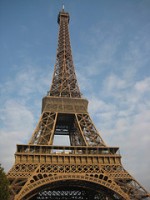
The Eiffel Tower, built in 1889, was a temporary structure. It was supposed to last only 20 years before being demolished. But Paris kept it, long, long past its design life. Why has it been so durable? Scientists are creating a detailed computer model of all of its components to try to answer that question:
But creating the model for the Eiffel Tower presented a technical challenge of a completely new kind.
One thing was that the realisation that its materials — puddle iron (iron that is super-heated, beaten by hand and then folded over) and rivets — perform quite differently from modern-day steel, concrete and bolts.
“We had to start from scratch,” said Roussin.
Materials scientists carried out mechanical and chemical tests on samples of puddle iron to assess its resilience, and stress engineers revisited Eiffel’s own drawings to calculate how the tower would perform under load from the natural elements.
Outwardly simple, the geometry of the tower itself posed some mighty number-crunching problems.
The programme had to take into account a range of weather conditions on a latticework of 18,000 metal pieces and the tower’s additions, calculating the load vertically, horizontally and in 3D: in all, the model has an astonishing million variables.
They’ve already learned that the tower has shrunk five and a half inches due to settling.
 The Eiffel Tower, built in 1889, was a temporary structure. It was supposed to last only 20 years before being demolished. But Paris kept it, long, long past its design life. Why has it been so durable? Scientists are creating a detailed computer model of all of its components to try to answer that question:
The Eiffel Tower, built in 1889, was a temporary structure. It was supposed to last only 20 years before being demolished. But Paris kept it, long, long past its design life. Why has it been so durable? Scientists are creating a detailed computer model of all of its components to try to answer that question:
No comments:
Post a Comment